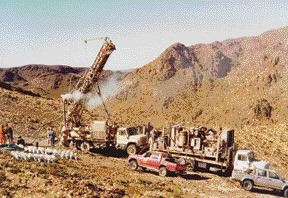Vancouver —
Reverse-circulation (RC) drilling tested extensions to known gold zones and returned significant intercepts from near the surface.
Drilling of potential extensions to the Ojo zone returned 12 metres grading 1.7 grams gold per tonne in hole 137 and 9 metres of 4.3 grams gold in hole 139. Mineralization east and south cut what appears to be faulted extensions of Ojo.
RC drilling east of the Luna zone returned up to 12 metres grading 2.4 grams gold in hole 148.
Drilling east and west of the Cuello Vein intersected parallel vein systems. The Cuello East and Cuello West returned 9 metres grading 5.5 grams gold in the hole 143 and 3 metres of 3.2 grams gold in hole 143.
Gold mineralization at La Cabeza occurs as disseminations and blebs in quartz veins, stockworks and siliceous breccias in the contact zone of the rhyolitic ignimbrite, and as fine-grained felsic porphyry intrusives. It is a low-sulphidation epithermal system.
A revised calculation has boosted La Cabeza’s inferred resource to 18.3 million tonnes grading 1.5 grams gold, based on a cutoff grade of 0.5 gram. That’s equivalent to 890,000 oz. gold. Exeter’s prefeasibility study will include the revised estimate.
The resource is primarily contained in the Cuello, Luna, Ojo and Mandibula zones, with minor amounts contributed from the Cachete and Labio zones.
The company is earning a 100% interest in La Cabeza in return for spending US$3 million on exploration and development and paying either $2.5 million or 2.5 million shares. The original property owners retain a 3.5% net smelter return royalty.
Exeter also has 25 epithermal gold-silver projects in Argentina’s Patagonia region, under option from a subsidiary of


Be the first to comment on "Exeter extends La Cabeza gold (May 23, 2005)"